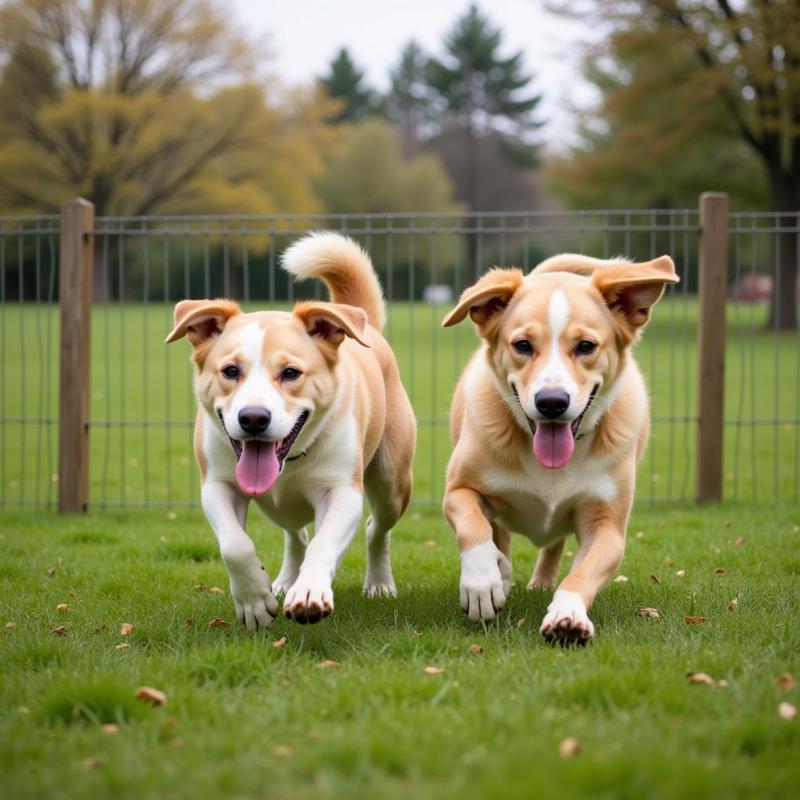Choosing an invisible dog fence for two furry friends can feel overwhelming. With so many options available, understanding the nuances of these systems is crucial for a safe and effective containment solution. This guide will explore the essential aspects of invisible dog fences for two dogs, covering everything from installation and training to breed-specific considerations and troubleshooting common issues. Let’s dive into creating a secure and happy environment for your canine companions.
Understanding Invisible Dog Fences for Multiple Dogs
Invisible or wireless dog fences utilize a buried wire or a central transmitter to create a defined boundary. A collar receiver worn by each dog emits a warning tone as they approach the boundary. If they continue, a mild static correction is delivered. While effective, these systems require proper training and understanding of your dogs’ temperaments and individual needs. Does one dog tend to wander more than the other? Are they both equally motivated by the correction? These are important factors to consider when choosing a system.
Choosing the Right Invisible Dog Fence System for Two Dogs
Selecting the right system involves considering several factors. First, evaluate the size of your containment area. Some systems are designed for larger properties, while others are better suited for smaller yards. Next, consider the temperament of your dogs. Some dogs are more sensitive to the static correction than others, and adjustable correction levels are crucial. Look for systems with multiple correction levels to cater to each dog’s individual sensitivity. Also, ensure the system you choose is explicitly designed for multiple dogs, meaning it can support multiple collars on the same signal.
Installing Your Invisible Dog Fence
Proper installation is critical for the effectiveness of the system. Whether you choose a wired or wireless system, carefully follow the manufacturer’s instructions. For wired systems, burying the wire at the correct depth is essential. Wireless systems require strategic placement of the transmitter for optimal coverage. Take the time to plan the layout and ensure the boundary is clearly defined, avoiding any ambiguous areas that could confuse your dogs.
Training Your Dogs with the Invisible Fence
Training is the most crucial aspect of using an invisible dog fence. Start by introducing your dogs to the collar and the boundary flags. Use positive reinforcement techniques to reward them for staying within the designated area. Gradually introduce the warning tone and correction, ensuring they understand the association between the signal and the boundary. Patience and consistency are key to successful training.
Troubleshooting Common Issues
Even with proper installation and training, some issues may arise. One common problem is inconsistent boundary signal. Check for breaks in the wire or interference from other electronic devices. Another issue could be one dog learning to run through the boundary while the other respects it. This often requires retraining and potentially adjusting the correction level for the dog pushing the boundaries.
Breed-Specific Considerations for Invisible Dog Fences
Certain breeds are more prone to ignoring the correction or testing the boundaries. Breeds with high prey drives or a stubborn nature may require more intensive training. For example, a Husky might be more likely to chase a squirrel despite the correction, while a Beagle’s strong nose might tempt it to explore beyond the boundary. Understanding your dog’s breed-specific traits is essential for tailoring your training approach.
Is an Invisible Fence Right for My Two Dogs?
Choosing an invisible dog fence is a big decision. Consider your dogs’ personalities, your property layout, and your commitment to training. While an effective solution for many, it’s not a one-size-fits-all solution.
 Is Invisible Fence Suitable?
Is Invisible Fence Suitable?
Conclusion
An invisible dog fence can be a valuable tool for containing two dogs, providing them with freedom and safety within a defined area. Careful selection of the system, meticulous installation, and patient training are essential for success. By understanding your dogs’ individual needs and addressing potential challenges proactively, you can create a secure and harmonious environment for your furry family members. Remember to consider your dogs’ breeds and temperaments and always prioritize their well-being.
FAQ
- Can I use one transmitter for two dogs? Yes, most invisible fence systems designed for multiple dogs use a single transmitter with multiple collars.
- What if one of my dogs is smaller than the other? Look for systems with adjustable correction levels to customize the settings for each dog’s size and sensitivity.
- How long does training usually take? Training time varies depending on the dog, but it typically takes a few weeks of consistent effort.
- What if my yard has a slope? Invisible fences can generally work on sloped yards, but the signal strength might vary. Consult the manufacturer’s guidelines.
- Are invisible fences safe for puppies? Most manufacturers recommend waiting until a puppy is at least six months old before using an invisible fence.
- What do I do if my dog keeps running through the fence? Check for breaks in the wire, increase the correction level, or retrain your dog.
- Can I use an invisible fence with a dog that has a heart condition? Consult with your veterinarian before using an invisible fence on a dog with any health concerns.
Related Articles
- underground dog fence for large dogs
- best dog collar for invisible fence
- boundary shock collar for dogs
- best above ground electric fence for dogs
- what can you put on grass to keep dogs off
Beautdogs.us is your premier resource for dog lifestyle information in the US, offering expert advice on breeds, care, and products. We provide a trusted source for both novice and experienced dog owners, ensuring your canine companion thrives. Contact us for personalized support! Email: [email protected] Phone: +1 501-555-7529. Visit Beautdogs.us today for more information.